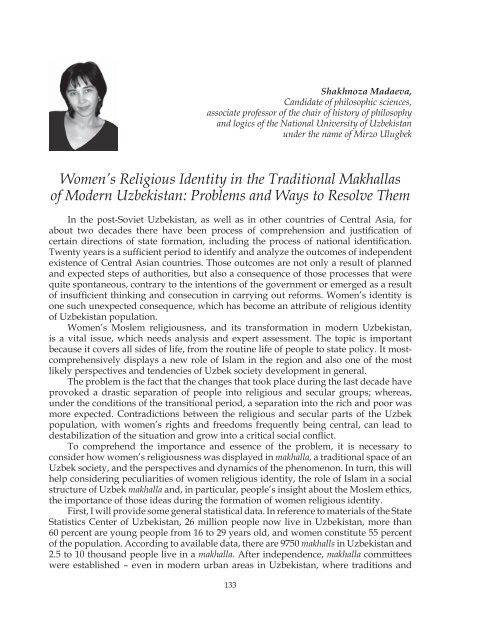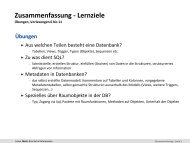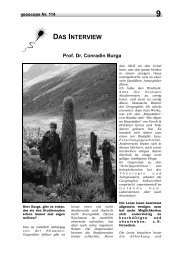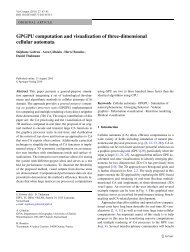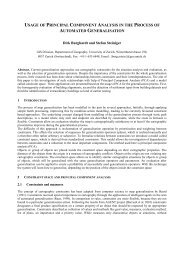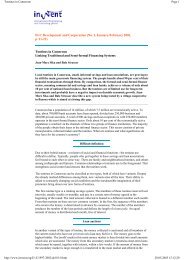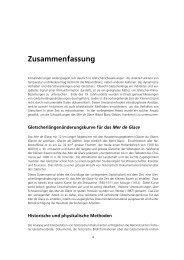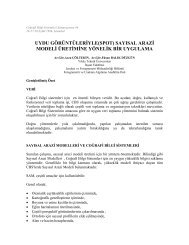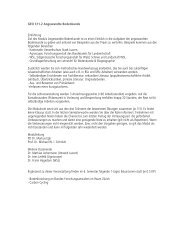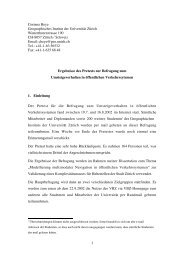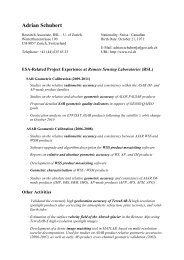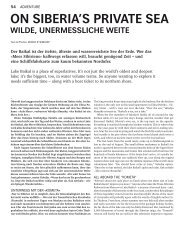KYRGYZSTAN TODAY Policy briefs on - Department of Geography
KYRGYZSTAN TODAY Policy briefs on - Department of Geography
KYRGYZSTAN TODAY Policy briefs on - Department of Geography
Create successful ePaper yourself
Turn your PDF publications into a flip-book with our unique Google optimized e-Paper software.
Shakhnoza Madaeva,<br />
Candidate <strong>of</strong> philosophic sciences,<br />
associate pr<strong>of</strong>essor <strong>of</strong> the chair <strong>of</strong> history <strong>of</strong> philosophy<br />
and logics <strong>of</strong> the Nati<strong>on</strong>al University <strong>of</strong> Uzbekistan<br />
under the name <strong>of</strong> Mirzo Ulugbek<br />
Women’s Religious Identity in the Traditi<strong>on</strong>al Makhallas<br />
<strong>of</strong> Modern Uzbekistan: Problems and Ways to Resolve Them<br />
In the post-Soviet Uzbekistan, as well as in other countries <strong>of</strong> Central Asia, for<br />
about two decades there have been process <strong>of</strong> comprehensi<strong>on</strong> and justificati<strong>on</strong> <strong>of</strong><br />
certain directi<strong>on</strong>s <strong>of</strong> state formati<strong>on</strong>, including the process <strong>of</strong> nati<strong>on</strong>al identificati<strong>on</strong>.<br />
Twenty years is a sufficient period to identify and analyze the outcomes <strong>of</strong> independent<br />
existence <strong>of</strong> Central Asian countries. Those outcomes are not <strong>on</strong>ly a result <strong>of</strong> planned<br />
and expected steps <strong>of</strong> authorities, but also a c<strong>on</strong>sequence <strong>of</strong> those processes that were<br />
quite sp<strong>on</strong>taneous, c<strong>on</strong>trary to the intenti<strong>on</strong>s <strong>of</strong> the government or emerged as a result<br />
<strong>of</strong> insufficient thinking and c<strong>on</strong>secuti<strong>on</strong> in carrying out reforms. Women’s identity is<br />
<strong>on</strong>e such unexpected c<strong>on</strong>sequence, which has become an attribute <strong>of</strong> religious identity<br />
<strong>of</strong> Uzbekistan populati<strong>on</strong>.<br />
Women’s Moslem religiousness, and its transformati<strong>on</strong> in modern Uzbekistan,<br />
is a vital issue, which needs analysis and expert assessment. The topic is important<br />
because it covers all sides <strong>of</strong> life, from the routine life <strong>of</strong> people to state policy. It mostcomprehensively<br />
displays a new role <strong>of</strong> Islam in the regi<strong>on</strong> and also <strong>on</strong>e <strong>of</strong> the most<br />
likely perspectives and tendencies <strong>of</strong> Uzbek society development in general.<br />
The problem is the fact that the changes that took place during the last decade have<br />
provoked a drastic separati<strong>on</strong> <strong>of</strong> people into religious and secular groups; whereas,<br />
under the c<strong>on</strong>diti<strong>on</strong>s <strong>of</strong> the transiti<strong>on</strong>al period, a separati<strong>on</strong> into the rich and poor was<br />
more expected. C<strong>on</strong>tradicti<strong>on</strong>s between the religious and secular parts <strong>of</strong> the Uzbek<br />
populati<strong>on</strong>, with women’s rights and freedoms frequently being central, can lead to<br />
destabilizati<strong>on</strong> <strong>of</strong> the situati<strong>on</strong> and grow into a critical social c<strong>on</strong>flict.<br />
To comprehend the importance and essence <strong>of</strong> the problem, it is necessary to<br />
c<strong>on</strong>sider how women’s religiousness was displayed in makhalla, a traditi<strong>on</strong>al space <strong>of</strong> an<br />
Uzbek society, and the perspectives and dynamics <strong>of</strong> the phenomen<strong>on</strong>. In turn, this will<br />
help c<strong>on</strong>sidering peculiarities <strong>of</strong> women religious identity, the role <strong>of</strong> Islam in a social<br />
structure <strong>of</strong> Uzbek makhalla and, in particular, people’s insight about the Moslem ethics,<br />
the importance <strong>of</strong> those ideas during the formati<strong>on</strong> <strong>of</strong> women religious identity.<br />
First, I will provide some general statistical data. In reference to materials <strong>of</strong> the State<br />
Statistics Center <strong>of</strong> Uzbekistan, 26 milli<strong>on</strong> people now live in Uzbekistan, more than<br />
60 percent are young people from 16 to 29 years old, and women c<strong>on</strong>stitute 55 percent<br />
<strong>of</strong> the populati<strong>on</strong>. According to available data, there are 9750 makhalls in Uzbekistan and<br />
2.5 to 10 thousand people live in a makhalla. After independence, makhalla committees<br />
were established – even in modern urban areas in Uzbekistan, where traditi<strong>on</strong>s and<br />
133


